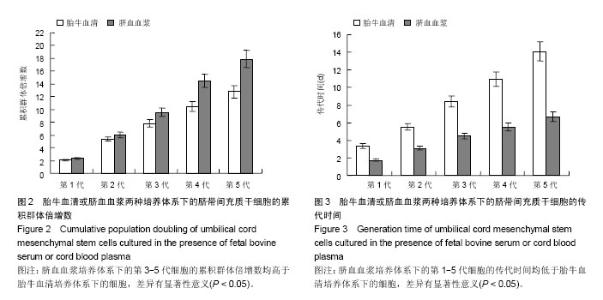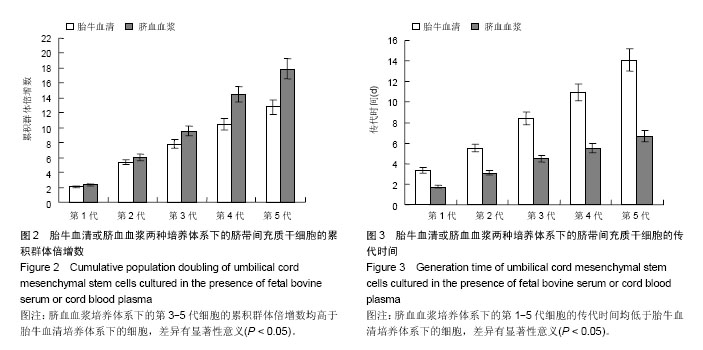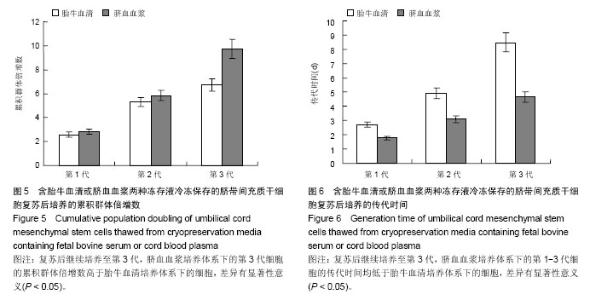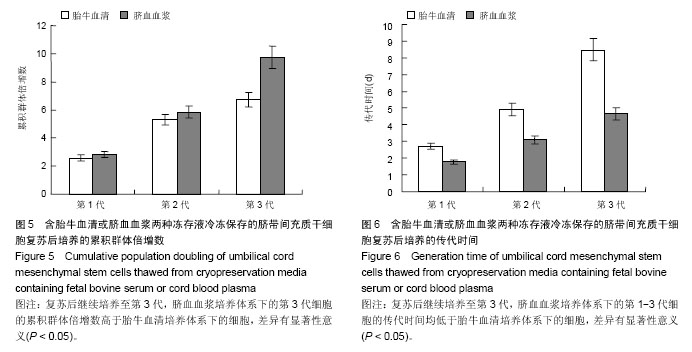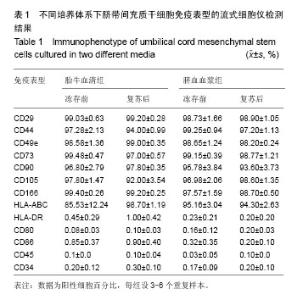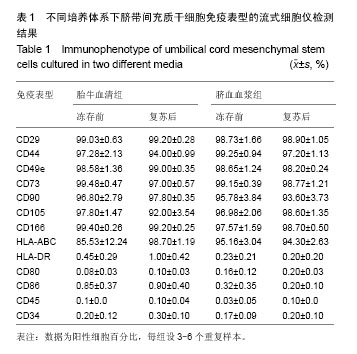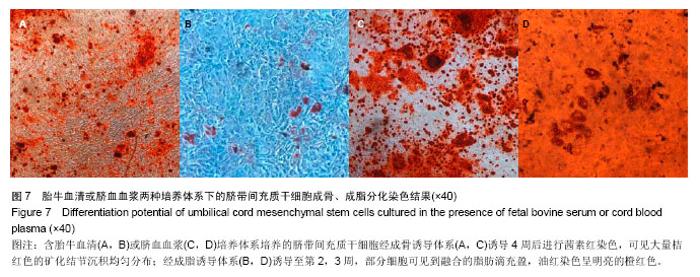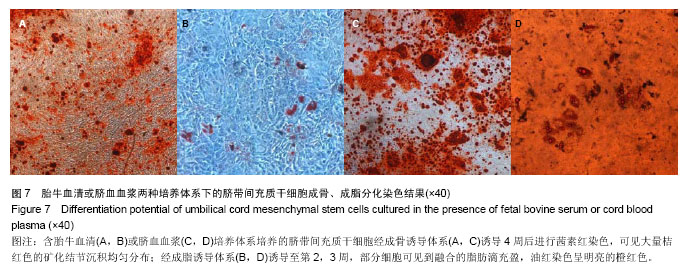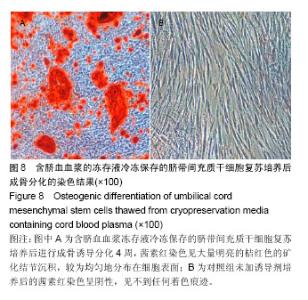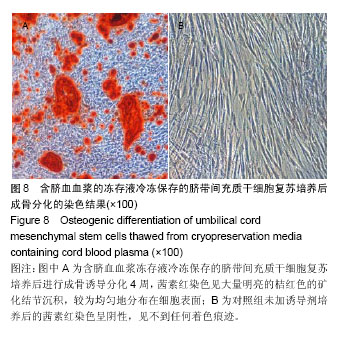Chinese Journal of Tissue Engineering Research ›› 2014, Vol. 18 ›› Issue (37): 5947-5954.doi: 10.3969/j.issn.2095-4344.2014.37.008
Previous Articles Next Articles
Human umbilical cord blood plasma can replace fetal bovine serum for primary culture, proliferation and cryopreservation of umbilical cord mesenchymal stem cells
Wu Jie-ying1, Lu Yan1, Chen Jin-song1, Zhu Lu2, Gan Wen-ting2
- 1Guangzhou Cord Blood Bank, Guangzhou Women and Children’s Medical Center, Guangzhou 510623, Guangdong Province, China; 2Department of Hematology, Guangzhou Women and Children’s Medical Center, Guangzhou 510623, Guangdong Province, China
-
Revised:2014-08-12Online:2014-09-03Published:2014-09-03 -
About author:Wu Jie-ying, Master, Senior technologist, Guangzhou Cord Blood Bank, Guangzhou Women and Children’s Medical Center, Guangzhou 510623, Guangdong Province, China -
Supported by:the Project of Guangdong Science and Technology Bureau, No. 2011B031800375; the Scientific Research Project of Guangzhou Health Bureau, No. 201102A213061; the Initial Project for Ph.D. of Guangzhou Women and Children’s Medical Center, No. 201011
CLC Number:
Cite this article
Wu Jie-ying, Lu Yan, Chen Jin-song, Zhu Lu, Gan Wen-ting. Human umbilical cord blood plasma can replace fetal bovine serum for primary culture, proliferation and cryopreservation of umbilical cord mesenchymal stem cells[J]. Chinese Journal of Tissue Engineering Research, 2014, 18(37): 5947-5954.
share this article
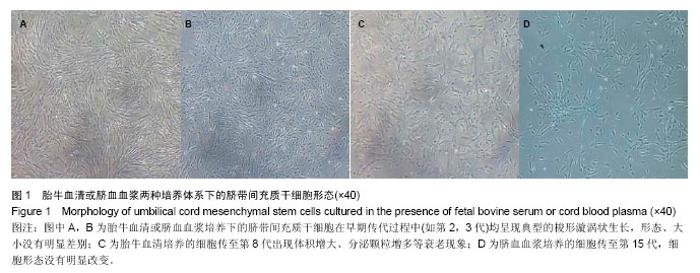
2.1 两种培养体系下的脐带来源间充质干细胞的形态及增殖 原代培养第5天大部分细胞贴壁,细胞呈梭形或角形,可见数个细胞集落形成。第2-3代的两组脐带来源间充质干细胞均呈现典型的梭形漩涡状生长,形态、大小没有明显差别;但第1组细胞(胎牛血清培养)传至第8代出现体积增大、分泌颗粒增多等衰老现象,而第2组细胞(脐血血浆培养)传至第15代,细胞形态没有明显改变,见图1。 两组细胞的累积群体倍增数(CPD)均呈上升趋势,第2组细胞(脐血血浆培养)第3-5代的累积群体倍增数均高于第1组细胞(胎牛血清培养),差异有显著性意义(P < 0.05),见图2;细胞传代时间反映细胞增殖能力,细胞所需要的传代时间(GT)越长,提示细胞活力下降,增殖能力降低,第2组细胞第1-5代的传代时间均低于第1组细胞,差异有显著性意义(P < 0.05),见图3。"
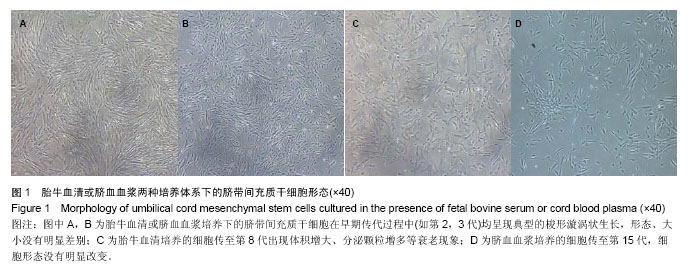
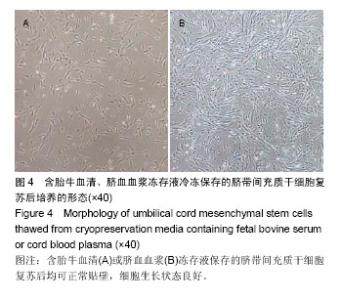
2.2 脐带来源间充质干细胞冻存复苏后观察 分别取两组第3代脐带间充质干细胞,置于含胎牛血清或脐血血浆的冻存液冷冻保存至少6个月后复苏。7-AAD标记检测的复苏后细胞活率分别为93.7%(胎牛血清冻存)及95.2%(脐血血浆冻存),24 h细胞贴壁率分别为78%(胎牛血清冻存)及89%(脐血血浆冻存);复苏后两组细胞的生长状态良好,见图4。体外继续培养至第3代,两组细胞的增殖情况与各自冻存前的实验结果没有明显差异,但在两组细胞之间进行比较,第2组细胞(脐血血浆培养)第3代累积群体倍增数高于第1组细胞(胎牛血清培养),差异有显著性意义(P < 0.05),见图5;第2组细胞第1-3代的传代时间均低于第1组细胞,差异有显著性意义(P < 0.05),见图6。"
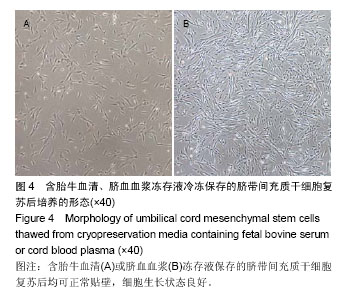
| [1] Sharma RR, Pollock K, Hubel A,et al.Mesenchymal stem or stromal cells: a review of clinical applications and manufacturing practices.Transfusion. 2014;54(5):1418-1437. [2] Salem HK, Thiemermann C.Mesenchymal stromal cells: current understanding and clinical status.Stem Cells. 2010; 28(3):585-596. [3] Patel AN, Genovese J.Potential clinical applications of adult human mesenchymal stem cell (Prochymal®) therapy.Stem Cells Cloning. 2011;4:61-72. [4] Chanda D, Kumar S, Ponnazhagan S.Therapeutic potential of adult bone marrow-derived mesenchymal stem cells in diseases of the skeleton.J Cell Biochem. 2010;111(2):249-257. [5] Schallmoser K, Rohde E, Reinisch A,et al.Rapid large-scale expansion of functional mesenchymal stem cells from unmanipulated bone marrow without animal serum.Tissue Eng Part C Methods. 2008;14(3):185-196. [6] Prockop DJ."Stemness" does not explain the repair of many tissues by mesenchymal stem/multipotent stromal cells (MSCs).Clin Pharmacol Ther. 2007;82(3):241-243. [7] Spees JL, Gregory CA, Singh H,et al.Internalized antigens must be removed to prepare hypoimmunogenic mesenchymal stem cells for cell and gene therapy.Mol Ther. 2004;9(5): 747-756. [8] Mannello F, Tonti GA.Concise review: no breakthroughs for human mesenchymal and embryonic stem cell culture: conditioned medium, feeder layer, or feeder-free; medium with fetal calf serum, human serum, or enriched plasma; serum-free, serum replacement nonconditioned medium, or ad hoc formula? All that glitters is not gold!Stem Cells. 2007; 5(7):1603-1609. [9] Tekkatte C, Gunasingh GP, Cherian KM,et al."Humanized" stem cell culture techniques: the animal serum controversy. Stem Cells Int. 2011;2011:504723. [10] Bieback K, Hecker A, Kocaömer A,et al.Human alternatives to fetal bovine serum for the expansion of mesenchymal stromal cells from bone marrow.Stem Cells. 2009;27(9):2331-2341. [11] Jung J, Moon N, Ahn JY,et al.Mesenchymal stromal cells expanded in human allogenic cord blood serum display higher self-renewal and enhanced osteogenic potential.Stem Cells Dev. 2009;18(4):559-571. [12] 吴洁莹,廖灿,许遵鹏,等.广州脐血库造血干细胞保存及临床应用[J].中华生物医学工程杂志,2010,16(5): 438-443. [13] Stolzing A, Jones E, McGonagle D,et al.Age-related changes in human bone marrow-derived mesenchymal stem cells: consequences for cell therapies.Mech Ageing Dev. 2008; 129(3):163-173. [14] Jung S, Panchalingam KM, Rosenberg L,et al. Ex vivo expansion of human mesenchymal stem cells in defined serum-free media.Stem Cells Int. 2012;2012:123030. [15] Dahl JA, Duggal S, Coulston N,et al.Genetic and epigenetic instability of human bone marrow mesenchymal stem cells expanded in autologous serum or fetal bovine serum.Int J Dev Biol. 2008;52(8):1033-1042. [16] Stute N, Holtz K, Bubenheim M,et al. Autologous serum for isolation and expansion of human mesenchymal stem cells for clinical use.Exp Hematol. 2004;32(12):1212-1225. [17] Felka T, Schäfer R, De Zwart P,et al.Animal serum-free expansion and differentiation of human mesenchymal stromal cells.Cytotherapy. 2010;12(2):143-153. [18] Turnovcova K, Ruzickova K, Vanecek V,et al. Properties and growth of human bone marrow mesenchymal stromal cells cultivated in different media.Cytotherapy. 2009;11(7):874-885. [19] Poloni A, Maurizi G, Rosini V,et al.Selection of CD271(+) cells and human AB serum allows a large expansion of mesenchymal stromal cells from human bone marrow. Cytotherapy. 2009;11(2):153-162. [20] Tateishi K, Ando W, Higuchi C,et al.Comparison of human serum with fetal bovine serum for expansion and differentiation of human synovial MSC: potential feasibility for clinical applications.Cell Transplant. 2008;17(5):549-557. [21] Le Blanc K, Samuelsson H, Lönnies L,et al. Generation of immunosuppressive mesenchymal stem cells in allogeneic human serum.Transplantation. 2007;84(8):1055-1059. [22] Flemming A, Schallmoser K, Strunk D,et al. Immunomodulative efficacy of bone marrow-derived mesenchymal stem cells cultured in human platelet lysate.J Clin Immunol. 2011;31(6):1143-1156. [23] Cholewa D, Stiehl T, Schellenberg A,et al.Expansion of adipose mesenchymal stromal cells is affected by human platelet lysate and plating density.Cell Transplant. 2011; 20(9):1409-1422. [24] Trojahn Kølle SF, Oliveri RS, Glovinski PV,et al.Pooled human platelet lysate versus fetal bovine serum-investigating the proliferation rate, chromosome stability and angiogenic potential of human adipose tissue-derived stem cells intended for clinical use.Cytotherapy. 2013;15(9):1086-1097. [25] Hemeda H, Giebel B, Wagner W.Evaluation of human platelet lysate versus fetal bovine serum for culture of mesenchymal stromal cells.Cytotherapy. 2014;16(2):170-180. [26] 吕江涛,田少奇,孙康,等.血小板裂解液对人脐带间充质干细胞体外成骨分化的影响[J].中国组织工程研究,2012,16(41): 7637-7641. [27] Abdelrazik H, Spaggiari GM, Chiossone L,et al.Mesenchymal stem cells expanded in human platelet lysate display a decreased inhibitory capacity on T- and NK-cell proliferation and function.Eur J Immunol. 2011;41(11):3281-3290. [28] Phadnis SM, Joglekar MV, Venkateshan V,et al.Human umbilical cord blood serum promotes growth, proliferation, as well as differentiation of human bone marrow-derived progenitor cells.In Vitro Cell Dev Biol Anim. 2006;42(10): 283-286. [29] Shetty P, Bharucha K, Tanavde V.Human umbilical cord blood serum can replace fetal bovine serum in the culture of mesenchymal stem cells.Cell Biol Int. 2007;31(3):293-298. [30] 旷文勇,周新伏,李睿娟,等.脐带血清和成人自体血清体外培养人骨髓间充质干细胞的比较[J].中国组织工程研究与临床康复, 2009,13(45):8917-8921. [31] 吴刚,何辉,曹月诚,等.不同血清培养条件下骨髓间充质干细胞的增殖[J].中国组织工程研究与临床康复,2010,14(49):9151- 9154. [32] Murphy MB, Blashki D, Buchanan RM,et al.Adult and umbilical cord blood-derived platelet-rich plasma for mesenchymal stem cell proliferation, chemotaxis, and cryo-preservation.Biomaterials. 2012;33(21):5308-5316. [33] 丁妍,卢智勇,袁雅红,等.脐血浆与胎牛血清培养人脐带间充质干细胞的比较[J]. 生物医学工程学杂志,2013,30(6):1279-1282. [34] Dominici M, Le Blanc K, Mueller I,et al.Minimal criteria for defining multipotent mesenchymal stromal cells. The International Society for Cellular Therapy position statement. Cytotherapy. 2006;8(4):315-317. [35] Horwitz EM, Le Blanc K, Dominici M,et al.Clarification of the nomenclature for MSC: The International Society for Cellular Therapy position statement.Cytotherapy. 2005;7(5):393-395. [36] Hemeda H, Kalz J, Walenda G,et al.Heparin concentration is critical for cell culture with human platelet lysate.Cytotherapy. 2013;15(9):1174-1181. [37] Jung S, Sen A, Rosenberg L,et al.Identification of growth and attachment factors for the serum-free isolation and expansion of human mesenchymal stromal cells.Cytotherapy. 2010; 12(5): 637-657. [38] Lindroos B, Boucher S, Chase L,et al.Serum-free, xeno-free culture media maintain the proliferation rate and multipotentiality of adipose stem cells in vitro.Cytotherapy. 2009;11(7):958-972. [39] Liu CH, Wu ML, Hwang SM. Optimization of serum free medium for cord blood mesenchymal stem cells. Biochem Eng J. 2007; 33: 1-9. [40] 周婷婷,卫超,陈晓东,等.无血清培养体系原代培养脐带间充质干细胞[J].中国组织工程研究,2013,17(27):4980-4987. |
| [1] | Pu Rui, Chen Ziyang, Yuan Lingyan. Characteristics and effects of exosomes from different cell sources in cardioprotection [J]. Chinese Journal of Tissue Engineering Research, 2021, 25(在线): 1-. |
| [2] | Lin Qingfan, Xie Yixin, Chen Wanqing, Ye Zhenzhong, Chen Youfang. Human placenta-derived mesenchymal stem cell conditioned medium can upregulate BeWo cell viability and zonula occludens expression under hypoxia [J]. Chinese Journal of Tissue Engineering Research, 2021, 25(在线): 4970-4975. |
| [3] | Jiang Hongying, Zhu Liang, Yu Xi, Huang Jing, Xiang Xiaona, Lan Zhengyan, He Hongchen. Effect of platelet-rich plasma on pressure ulcers after spinal cord injury [J]. Chinese Journal of Tissue Engineering Research, 2021, 25(8): 1149-1153. |
| [4] | Hou Jingying, Yu Menglei, Guo Tianzhu, Long Huibao, Wu Hao. Hypoxia preconditioning promotes bone marrow mesenchymal stem cells survival and vascularization through the activation of HIF-1α/MALAT1/VEGFA pathway [J]. Chinese Journal of Tissue Engineering Research, 2021, 25(7): 985-990. |
| [5] | Shi Yangyang, Qin Yingfei, Wu Fuling, He Xiao, Zhang Xuejing. Pretreatment of placental mesenchymal stem cells to prevent bronchiolitis in mice [J]. Chinese Journal of Tissue Engineering Research, 2021, 25(7): 991-995. |
| [6] | Liang Xueqi, Guo Lijiao, Chen Hejie, Wu Jie, Sun Yaqi, Xing Zhikun, Zou Hailiang, Chen Xueling, Wu Xiangwei. Alveolar echinococcosis protoscolices inhibits the differentiation of bone marrow mesenchymal stem cells into fibroblasts [J]. Chinese Journal of Tissue Engineering Research, 2021, 25(7): 996-1001. |
| [7] | Fan Quanbao, Luo Huina, Wang Bingyun, Chen Shengfeng, Cui Lianxu, Jiang Wenkang, Zhao Mingming, Wang Jingjing, Luo Dongzhang, Chen Zhisheng, Bai Yinshan, Liu Canying, Zhang Hui. Biological characteristics of canine adipose-derived mesenchymal stem cells cultured in hypoxia [J]. Chinese Journal of Tissue Engineering Research, 2021, 25(7): 1002-1007. |
| [8] | Geng Yao, Yin Zhiliang, Li Xingping, Xiao Dongqin, Hou Weiguang. Role of hsa-miRNA-223-3p in regulating osteogenic differentiation of human bone marrow mesenchymal stem cells [J]. Chinese Journal of Tissue Engineering Research, 2021, 25(7): 1008-1013. |
| [9] | Lun Zhigang, Jin Jing, Wang Tianyan, Li Aimin. Effect of peroxiredoxin 6 on proliferation and differentiation of bone marrow mesenchymal stem cells into neural lineage in vitro [J]. Chinese Journal of Tissue Engineering Research, 2021, 25(7): 1014-1018. |
| [10] | Zhu Xuefen, Huang Cheng, Ding Jian, Dai Yongping, Liu Yuanbing, Le Lixiang, Wang Liangliang, Yang Jiandong. Mechanism of bone marrow mesenchymal stem cells differentiation into functional neurons induced by glial cell line derived neurotrophic factor [J]. Chinese Journal of Tissue Engineering Research, 2021, 25(7): 1019-1025. |
| [11] | Duan Liyun, Cao Xiaocang. Human placenta mesenchymal stem cells-derived extracellular vesicles regulate collagen deposition in intestinal mucosa of mice with colitis [J]. Chinese Journal of Tissue Engineering Research, 2021, 25(7): 1026-1031. |
| [12] | Pei Lili, Sun Guicai, Wang Di. Salvianolic acid B inhibits oxidative damage of bone marrow mesenchymal stem cells and promotes differentiation into cardiomyocytes [J]. Chinese Journal of Tissue Engineering Research, 2021, 25(7): 1032-1036. |
| [13] | Wang Xianyao, Guan Yalin, Liu Zhongshan. Strategies for improving the therapeutic efficacy of mesenchymal stem cells in the treatment of nonhealing wounds [J]. Chinese Journal of Tissue Engineering Research, 2021, 25(7): 1081-1087. |
| [14] | Wang Shiqi, Zhang Jinsheng. Effects of Chinese medicine on proliferation, differentiation and aging of bone marrow mesenchymal stem cells regulating ischemia-hypoxia microenvironment [J]. Chinese Journal of Tissue Engineering Research, 2021, 25(7): 1129-1134. |
| [15] | Kong Desheng, He Jingjing, Feng Baofeng, Guo Ruiyun, Asiamah Ernest Amponsah, Lü Fei, Zhang Shuhan, Zhang Xiaolin, Ma Jun, Cui Huixian. Efficacy of mesenchymal stem cells in the spinal cord injury of large animal models: a meta-analysis [J]. Chinese Journal of Tissue Engineering Research, 2021, 25(7): 1142-1148. |
| Viewed | ||||||
|
Full text |
|
|||||
|
Abstract |
|
|||||
